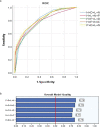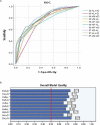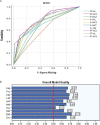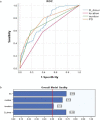A longitudinal observational retrospective study on risk factors and predictive model of PICC associated thrombosis in cancer patients
- PMID: 32572092
- PMCID: PMC7308336
- DOI: 10.1038/s41598-020-67038-x
A longitudinal observational retrospective study on risk factors and predictive model of PICC associated thrombosis in cancer patients
Abstract
To analyze the incidence of PICC associated venous thrombosis. To predict the risk factors of thrombosis. To validate the best predictive model in predicting PICC associated thrombosis. Consecutive oncology cases in 341 who initially naive intended to be inserted central catheter for chemotherapy, were recruited to our dedicated intravenous lab. All patients used the same gauge catheter, Primary endpoint was thrombosis formation, the secondary endpoint was infusion termination without thrombosis. Two patients were excluded. 339 patients were divided into thrombosis group in 59 (17.4%) and non-thrombosis Group in 280 (82.6%), retrospectively. Tumor, Sex, Age, Weight, Height, BMI, BSA, PS, WBC, BPC, PT, D-dimer, APTT, FIB, Smoking history, Location, Catheter length, Ratio and Number as independent variables were analyzed by Fisher's scoring, then Logistic risk regression, ROC analysis and nomogram was introduced. Total incidence was 17.4%. Venous mural thrombosis in 2 (3.4%), "fibrin sleeves" in 55 (93.2%), mixed thrombus in 2 (3.4%), symptomatic thrombosis in 2 (3.4%), asymptomatic thrombosis in 57 (96.6%), respectively. Height (χ² = 4.48, P = 0.03), D-dimer (χ² = 37.81, P < 0.001), Location (χ² = 7.56, P = 0.006), Number (χ² = 43.64, P < 0.001), Ratio (χ² = 4.38, P = 0.04), and PS (χ² = 58.78, P < 0.001), were statistical differences between the two groups analyzed by Fisher's scoring. Logistic risk regression revealed that Height (β = -0.05, HR = 0.95, 95%CI: 0.911-0.997, P = 0.038), PS (β = 1.07, HR = 2.91, 95%CI: 1.98-4.27, P < 0.001), D-dimer (β0.11, HR = 1.12, 95%CI: 1.045-1.200, P < 0.001), Number (β = 0.87, HR = 2.38, 95% CI: 1.619-3.512, P < 0.001) was independently associated with PICC associated thrombosis. The best prediction model, D-dimer + Number as a novel co-variable was validated in diagnosing PICC associated thrombosis before PICC. Our research revealed that variables PS, Number, D-dimer and Height were risk factors for PICC associated thrombosis, which were slightly associated with PICC related thrombosis, in which, PS was the relatively strongest independent risk factor of PICC related thrombosis.
Conflict of interest statement
The authors declare no competing interests.
Figures








Similar articles
-
Construction of a nomogram risk prediction model for PICC-related venous thrombosis and its application.Asian J Surg. 2024 Jan;47(1):107-111. doi: 10.1016/j.asjsur.2023.05.043. Epub 2023 Jun 9. Asian J Surg. 2024. PMID: 37302889
-
The association between ABO blood types and peripherally inserted central catheter-related venous thrombosis for patients with cancer: A retrospective 7-year single-center experience and meta-analysis.PLoS One. 2024 Jul 1;19(7):e0305746. doi: 10.1371/journal.pone.0305746. eCollection 2024. PLoS One. 2024. PMID: 38950056 Free PMC article.
-
Influence Factors Analyses of PICC-Related Bloodstream Infection, PICC-Related Venous Thrombosis, and Infected Puncture Site and Their Influence on Cancer Patients' Death: A Retrospective Cross-Sectional Study.Cancer Med. 2025 Apr;14(7):e70841. doi: 10.1002/cam4.70841. Cancer Med. 2025. PMID: 40171872 Free PMC article.
-
Peripherally inserted central catheter (PICC)-related thrombosis in critically ill patients.J Vasc Access. 2014 Sep-Oct;15(5):329-37. doi: 10.5301/jva.5000239. Epub 2014 Apr 25. J Vasc Access. 2014. PMID: 24811591 Review.
-
Peripherally inserted central venous catheters are not superior to central venous catheters in the acute care of surgical patients on the ward.World J Surg. 2006 Aug;30(8):1605-19. doi: 10.1007/s00268-005-0174-y. World J Surg. 2006. PMID: 16865322 Review.
Cited by
-
Risk factors for peripherally inserted central venous catheter-related complications in children: A retrospective cohort study.Medicine (Baltimore). 2023 Sep 29;102(39):e34924. doi: 10.1097/MD.0000000000034924. Medicine (Baltimore). 2023. PMID: 37773817 Free PMC article.
-
Development of a Machine Learning-Based Model for Predicting the Incidence of Peripheral Intravenous Catheter-Associated Phlebitis.J Crit Care Med (Targu Mures). 2024 Jul 31;10(3):232-244. doi: 10.2478/jccm-2024-0028. eCollection 2024 Jul. J Crit Care Med (Targu Mures). 2024. PMID: 39108413 Free PMC article.
-
Catheter-related bloodstream infection associated with multiple insertions of the peripherally inserted central catheter in patients with hematological disorders.Sci Rep. 2021 Jun 9;11(1):12209. doi: 10.1038/s41598-021-91749-4. Sci Rep. 2021. PMID: 34108612 Free PMC article.
-
Application value of modified skin expansion in PICC catheterization under the guidance of B-ultrasound in gastrointestinal cancer patients with chemotherapy.Am J Transl Res. 2022 Nov 15;14(11):7932-7941. eCollection 2022. Am J Transl Res. 2022. PMID: 36505288 Free PMC article.
-
Development and validation of a risk prediction model for PICC-related venous thrombosis in patients with cancer: a prospective cohort study.Sci Rep. 2025 Feb 7;15(1):4654. doi: 10.1038/s41598-025-89260-1. Sci Rep. 2025. PMID: 39920370 Free PMC article.
References
-
- Herbst S. Option for venous access in ambulatory care: issues in selection and management. J. Infus. Chemother. 1996;6:186–194. - PubMed
Publication types
MeSH terms
LinkOut - more resources
Full Text Sources
Medical
Miscellaneous

